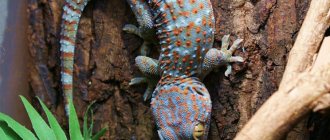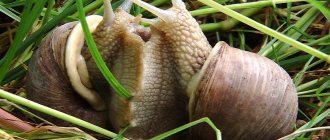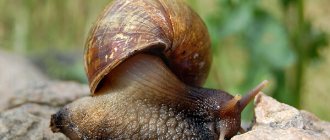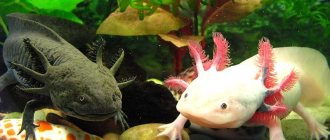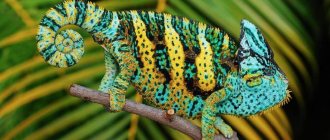Salamander - an amphibian, which in ancient times people were very afraid of, they composed legends about it, revered it, and also attributed magical abilities. This was due to the appearance of the salamander and its behavior. For a long time, people believed that animals do not burn in fire because they themselves are made of fire. Indeed, translated from the language of the ancient Persians, salamander means “burning from the inside.”
CLASSIFICATION
Species: salamander Order: caudate amphibians Type: chordates Family: true salamanders Subfamily: salamanders Class: amphibians Dimensions: body length - 15 mm - 170 cm, in most cases - 20 - 25 cm; body weight - from 30 mg to 80 kg Life expectancy: on average 20 - 25 years, but can reach 50 years of age in captivity.
Spreading
Lives in Europe from Spain and Portugal in the west to western Russia, Turkey and Israel in the east. Some salamanders live exclusively in water and differ from their relatives by well-formed gills, for example, the Chinese giant salamander is a representative of the cryptobranch . Salamanders belonging to the family of cryptobranchs live in the United States of America, China and Japan.
the family of lungless salamanders completely lost their lungs without gaining gills. Therefore, members of the family have to breathe using the skin and mucous membranes of the mouth. These salamanders live in tropical and subtropical forests, in mountains and lowlands, on plantations and in village gardens. Lungless salamanders are inhabitants of predominantly New World countries: they are distributed in areas covering the mountainous and forested areas of Canada, including the tropics and subtropics of Bolivia and Brazil. Several species live in European countries, and only one species (lat. Karsenia koreana) can be found in South Korea.
Representatives of the family of true salamanders , leading a predominantly terrestrial existence, have a respiratory system represented by a pair of well-developed lungs. True salamanders are widespread throughout Europe, living in the north-west of the African continent, Asia Minor and China, small species populations are found in Indochina and India, the range also covers areas from southern Canada to the northern regions of Mexico. Only four species of salamanders live in Russia.
Characteristics and structure of the animal
Some species of these amphibians have a dense and strong body (this includes the fire salamander), other representatives have a slender and graceful figure. The size of the smallest amphibian can be 5 cm, the largest reaches a length of one meter 80 cm, including the tail.
The color of amphibians is replete with a wealth of shades. The color range of the animal is brown, yellow, rich light green, light gray and red. The amphibian can be painted in one tone or have different shades that turn into geometric patterns.
The fire salamander is framed in a bright black and orange color and is considered the most aesthetically attractive individual of the entire class.
Absolutely every representative has short legs. The forelimbs of most species, including the fire salamander, have four fingers, and the hind limbs have five. Some varieties have very poorly developed paws, while others have stronger and more athletic paws.
The head of the fire (spotted) salamander has a convex and partly flattened shape. It contains parotids - skin glands that are produced by all amphibians. The secretions produce a poisonous secretion called bufotoxin, which contains alkaloids and substances that cause paralysis in small mammals. The amphibian's black eyes are somewhat bulging, and the eyelids are formed, which is not always observed in other species.
The fire salamander is an animal endowed with the exceptional ability to regenerate lost limbs
and
the tail section
. On average, an amphibian lives about 18 years, but the duration of existence varies depending on its appearance. The fire salamander, confined in the narrow confines of captivity, can live 50 years.
Most species of amazing amphibians are listed in the Red Book. Many of them are under threat of complete destruction. They are mercilessly exterminated to obtain delicious meat for national cuisine and poison, which treats many pathologies.
Some species live exclusively in water spaces and are endowed with full gills. Such amphibians thrive in the United States, China and the islands of Japan. Other representatives do not have lungs at all, so they breathe using the skin and mucous membranes of the mouth. They live in hot tropical forests
, in low mountains, on cultivated plantations and in rural settlements of the New World.
Many representatives have a complete respiratory system and lead a terrestrial lifestyle.
. They are widespread in areas of Europe, China and northwest Africa.
The fire salamander loves to explore territories of deciduous or mixed forests near rivers and lakes. This species is widespread on the European continent and the Middle East. Sometimes the animal can be spotted in Ukraine. The spotted (fire) salamander is extremely slow during the day, when it hides in decrepit stumps, abandoned holes or tall grass. Since she is a cold-blooded animal, she needs to hide from the burning rays of the sun. From mid-autumn until the snow melts in early spring, the fire salamander falls into deep hibernation. The best place for this is large piles of fallen leaves. Representatives of the species like to gather in a large group (10-12 individuals) and spend such a cold winter.
This black and orange amphibian feasts on small spiders
and she drinks
the morning dew
. The animal does not disdain worms, mollusks, various insects and their larvae. Sometimes it can swallow a small newt or frog. The amphibian itself is dinner for some animals. Its worst enemy is birds and wild boars, who also eat this small animal with great appetite. When an animal is in reservoirs or lakes, it becomes a victim of the sharp fangs of pike and other predatory fish.
The fire salamander's breeding season begins immediately after it emerges from hibernation. Mating games take place on land. During this period, specific sacs with germ cells (spermatophore) are formed on the body of males. When the female presses against the testis, fertilization occurs. A certain number of eggs are laid in the water, the rest remain in the mother's body.
It follows that there are two ways for a fire salamander to be born: origin from the womb of a female and birth from a fertilized egg in an aquatic environment. The small amphibian becomes an adult when it reaches three years of age. They have the opportunity to reproduce.
Appearance
The main difference from a lizard is that the salamander has moist and smooth skin, as well as a complete absence of claws. The tailed amphibian has an elongated body that smoothly merges into the tail. Some species have a fairly dense and stocky build, including
The fire salamander, and other members of the family are characterized by a slender and sophisticated body. All species are distinguished by short legs, but some have not very well developed limbs. Most species are distinguished by the presence of four toes on each front leg, and five on the hind legs.
The salamander's head has an elongated and slightly flattened shape, bulging black eyes with, as a rule, fairly well-developed eyelids. In the area of the amphibian's head there are specific skin glands called parotids, which are characteristic of absolutely all amphibians. The main function of such special glands is the production of a toxic secretion - bufotoxin, which contains alkaloids with a neurotoxic effect that quickly causes the development of seizures or paralysis in different species of mammals.
This is interesting! Often the color of a salamander combines several shades of different colors, which are very originally transformed into stripes, specks and spots that differ in shape or size.
In accordance with the species characteristics, the length of an adult can vary between 5-180 cm, and a distinctive feature of some representatives of long-tailed salamanders is that the length of the tail is significantly longer than the length of the body. The color of the salamander can also be very diverse, but the Fire salamander, which has a bright blackish-orange color, deservedly belongs to the list of the most beautiful species at the moment. The color of other representatives may well be simply plain, black, brown, yellow and olive, as well as gray or reddish.
Description
Fire salamander, rare orange color
Adult fire salamanders reach 23 cm in length, according to some data up to 30 cm, the average body length is 16-19 cm, including the tail. The length of the tail is less than half of the total body length. The tail is round in cross section, very mobile (can move the tip). The stocky body is predominantly intensely black with irregularly shaped yellow or orange spots. The shape and location of the spots are varied and variable. Often the spots merge and form stripes. Often the spots on the head and paws are symmetrical, the rest are placed randomly, but evenly across the body. The bright, contrasting coloration of the salamander (also called aposematic, that is, warning) serves to warn enemies that their prey is poisonous. The abdomen is usually black or brown, uniformly colored, with lighter spots possible. The limbs are short and strong, without swimming membranes. There are four toes on the front paws and five on the hind paws.
The salamander's head is massive and round. Large convex eyes are completely black, the eyelids are well developed. You can distinguish a female from a male by its larger body size, shorter limbs and less convex cloaca. Females are wider.
parotid glands are located on the head
having an alveolar structure. The glands produce poison, which in appearance is a viscous milky liquid with a specific odor of almonds or garlic. Its main components are the steroid alkaloids samandarin, samandaron, cycloneosamandarone and others. In total, salamander venom contains 9 alkaloids similar in structure. The poison is toxic for mammals (the average lethal dose is 20-30 mg/kg for mice). The venom acts as a neurotoxin and causes paralysis, arrhythmia and convulsions. It also has antibacterial and antifungal effects. For the salamander, the venom serves as protection against predators and infections. Salamander venom is not dangerous to humans, but contact of the venom on the mucous membranes causes a burning sensation. Under severe stress, the salamander is capable of spraying poison over a short distance.
What does a salamander eat?
What salamanders eat depends mainly on their habitat. For example, small amphibians living on land hunt flies, mosquitoes, butterflies, spiders, cicadas, earthworms, and slugs. Larger salamanders prefer to hunt small lizards, newts, and frogs. Animals living in reservoirs catch crustaceans, mollusks, small fish, and fry.
When climatic conditions permit, amphibians can hunt all year round. The period of greatest activity of salamanders occurs at night. In the dark, they come out of their hiding places to walk and hunt, and they can do this from the evening until dawn.
To catch their prey, they first watch it for a long, long time without moving, thanks to their bulging eyes and moving eyelids. Salamanders catch prey by throwing out their long, sticky tongue. If the animal manages to get closer to the prey unnoticed, then it will probably not be able to escape.
Having caught their prey with a sharp movement, they lean on it with their whole body and try to swallow it whole without chewing. After all, the salamander’s jaws and mouth are not at all suited for chewing. With small animals (insects, slugs) everything turns out simply, with larger prey (lizards, frogs) the animal has to really try. But then the salamander feels full for several days.
Character and lifestyle of the salamander
Salamanders, although they are loners, gather in groups before hibernation in October. To survive this unfavorable period for them together on land, in heaps of fallen leaves.
They hunt mainly at night, and during the day they hide in shelters from direct rays of the sun. As a rule, there should be a body of water near their habitat. They overtake their prey with a sharp jerk and cover it with their body. After a short struggle, the victim is swallowed whole.
The salamander has many natural enemies; in order to escape, the animal leaves its tail or limbs in their claws and teeth and quickly runs away.
Although these amphibians are poisonous, their secretion does not cause mortal harm to humans. It can only cause irritation on the hands, and if it gets on the mucous membranes, it can burn the mouth or eyes. Therefore, after touching an amphibian, you need to wash your hands well so as not to harm yourself through carelessness.
Today, many people want to keep this mythical amphibian at home. You can buy fire salamanders in special nurseries or pet stores. They will need a large horizontal terrarium to live. A mixture of leaves, sphagnum and peat is usually poured onto its bottom. There is a small pond inside. The lighting should be dim and the temperature should not exceed 25 degrees.
Nutrition
Before purchasing an exotic animal, you need to research what it eats. And the main thing is to think about whether you can provide it with the treats that it prefers, since, for example, crickets or slugs, so beloved by salamanders, cannot be bought at any pet store or at any pet market.
You need to feed the amphibian the same thing it eats in the wild, namely:
- woodlice;
- earthworms and mealworms;
- caterpillars;
- snails;
- grasshoppers;
- bloodworm;
- mice (live one-day old).
Feeding should be done once every two days. You should also worry about purchasing a vitamin-mineral complex at a pet store, which will need to be periodically introduced into the animal’s diet. Having prepared the vitamin solution, it is poured with a syringe into the insect, which is then fed to the amphibian, or the food is simply sprinkled with dry vitamin powder. Vitamins should be given once a week.
You can train a salamander to eat from your hands, but it is better to feed it using special tweezers. Just be careful not to injure the animal. It is best to present the treat at a distance of 1 cm from the animal. Having noticed prey, the amphibian, as a rule, makes a lightning-fast throw. The animal swallows the food whole.
You can also try to teach the amphibian to eat from one specific place, adapting, for example, a small saucer or pebble for this purpose.
You need to offer food until the animal begins to refuse it. Overfeeding the amphibian is not recommended. Fire and tiger amphibians are especially prone to overeating.
After the animal is satisfied, excess food must be removed from the terrarium.
Important! It would be useful for the owner of a pet salamander to know that when it molts, it usually refuses to eat. During this period, she can spend quite a long time without food. This is normal and should not be a cause for concern.
How long do salamanders live?
The average recorded lifespan of tailed amphibians is approximately seventeen years. However, among all the species diversity of this genus, there are also true long-livers. For example, the average lifespan of the Japanese giant salamander may well exceed half a century. Fire salamanders live in captivity for about four to five decades, and in nature the total lifespan of this species does not exceed, as a rule, fourteen years. Representatives of the Alpine salamander species live in their natural habitat for no more than ten years.
Socialization / Taming
Taming: they are easily tamed, recognize the owner’s steps, and take food from tongs or hands with pleasure. Compatibility: two males will not get along in one terrarium, since the individual territory for each male must be at least 10 m2. Character: peaceful and harmless, not aggressive towards humans.
Fire salamander larva
Salamander species
Today, salamanders are represented by seven main species, but only a few of them are the most studied:
- Alpine or black salamander (Salamandra atra) is an animal that resembles a fire salamander in appearance, but is distinguished by a more slender body, smaller size and a predominantly uniform shiny black color (with the exception of the subspecies Salamandra atra auroae, which has an upper body and head colored in bright yellow color). The length of an adult individual is, as a rule, no more than 90-140 mm. Subspecies of the alpine salamander: Salamandra atra atra, Salamandra atra auroae and Salamandra atra prenjensis;
- The Lanza salamander (Salamandra lanzai) is a tailed amphibian belonging to the family of true salamanders and named after the herpetologist from Italy Benedeto Lanza. Representatives of this species have a black body, an average length of 110-160 mm, a flat head, a rounded and pointed tail;
- Pacific salamander (Ensatina esсhscholtzii) is a species distinguished by a small and thick head, as well as a slender but strong body up to 145 mm long, covered on the sides with wrinkled and folded skin;
- The fiery or spotted common salamander (Salamandra salamandra) is an animal that is one of the most currently known species of Salamander and the largest representative of this family. The fire salamander has a noticeable bright black and yellow coloration, and the length of adults can easily reach 23-30 cm.
Subspecies belonging to the species Fire salamanders:
- S.s. gallaica;
- S.s. Linneаus – nominative subspecies;
- S.s. alfredschmidti;
- S.s. Müller and Hellmich;
- S.s. bejarae Mertens and Müller;
- S.s. bernardezi Gasser;
- S.s. beshkovi Obst;
- S.s. crespoi malkmus;
- S.s. fastuosa (bonalli) Eiselt;
- S.s. galliasa Nikolskii;
- S.s. gigliolii Eiselt and Lanza;
- S.s. Mertens and Muller;
- S.s. infraimmaculata;
- S.s. longirostris Joger and Steinfartz;
- S.s. morenica Joger and Steinfartz;
- S.s. semenovi;
- S.s. terrestris Eiselt.
Also, a typical representative of tailed amphibians, belonging to the family of true salamanders, is Salamandra infraimmaculata. The large amphibian reaches a length of 31-32 cm, but females are noticeably larger than males. The skin on the back is black with yellow or orange spots, and the abdominal area is characterized by black coloring.
Social structure and reproduction
On average, salamanders can live up to 20 years, but their life expectancy depends on the specific species and habitat. Small species of these animals become sexually mature at 3 years, and large ones later - at 5 years.
Cryptobranch salamanders lay eggs, and true salamanders can be either viviparous or ovoviviparous. Amphibians can reproduce throughout the year, but the peak of mating activity occurs in the spring months.
When a male salamander is ready to mate, a special gland swells and is filled with spermatophore—male reproductive cells. He is very excited and the main goal of his life at this moment is to find a female and fulfill the duty of procreation. If there are several contenders for the female’s attention, then the males may fight.
Males release the spermatophore directly onto the ground, and females absorb it through the cloaca. In water, the fertilization process occurs differently: females lay eggs, and males water them with spermatophore.
Fertilized eggs attach to algae stems or roots. In viviparous species, larvae develop inside the womb within 10-12 months. In aquatic salamanders, the young hatch from eggs after about 2 months with fully formed gills. In appearance, the larvae are somewhat reminiscent of tadpoles.
Interesting fact: In viviparous salamanders, out of 30-60 fertilized eggs, only 2-3 babies are born, and the remaining eggs are just food for future offspring.
Salamander larvae live and feed in water for about three months, gradually transforming and acquiring the appearance of adults. Before the completion of metamorphosis, small salamanders crawl a lot along the bottom of reservoirs and often emerge, trying to breathe air. Young individuals have no connections with their parents and upon completion of metamorphosis they begin their independent life.
Natural enemies
The salamander has a lot of natural enemies, and in order to save its life, such an unusual animal has adapted to leaving its limbs or tail in the teeth or claws of predators in order to have time to escape. For example, the natural enemies of the Fire Salamander species are snakes, including common and water snakes, predatory fish, large birds and wild boars.
Salamanders are often caught by people, since today many connoisseurs of various indoor exotics prefer keeping such a mythical amphibian at home. For humans, the poison secreted by salamanders is not dangerous and contact of the toxin with the mucous membranes only causes a burning sensation, but under conditions of too much stress such an animal is capable of spraying toxic substances over a relatively long distance.
Keeping at home
These amphibians are kept in a terrarium at home. It is necessary to fill the bottom with soil. It should be a mixture of soil, moss, coal and peat. Salamanders love to burrow into moss. But it dries out quite quickly. Therefore, it needs to be updated periodically. To create conditions as close as possible to natural conditions, it is important to place one more thing in your pet’s house. These are dry driftwood, stones, and it is also good to plant several living plants.
The amphibian enjoys taking baths. Therefore, it is necessary to place a pond in the terrarium. Be sure to keep it clean. Change the water and rinse the container from time to time. It is not recommended to place two males in one house. The ideal option is several females and one male.
The salamander does not tolerate heat very well. Therefore, it is best to place the terrarium in dark places. For lighting, use fluorescent lamps, which must be purchased additionally. Buy a humidifier too. The humidity in the pet's home must be constantly maintained at a level of at least 75%.
It is often not recommended to pick up an amphibian. Animals do not like too much tactile contact. In addition, they secrete a secretion that can cause irritation on the skin. It is important to create a balanced diet for your pet. Despite being kept in captivity, salamanders have an excellent appetite. The main thing is not to overfeed them. You need to give food 2 times a day. Please note that pets may completely refuse to eat for several days, or even weeks. This is normal before shedding and during hot weather.
The main diet of salamanders should consist of live insects. These are slugs, butterflies, beetles, crickets, caterpillars and flies. Sometimes you can give some fresh fish, beef liver or heart - also raw.
Tips for choosing an animal
When choosing an amphibian, you need to pay attention to the fact that it is moderately well-fed and not obese. If its ribs are visible, then it is better to refuse to buy such an animal.
It is important to pay attention to the salamander's skin. It should be clean, smooth and moist. It needs to be examined for damage and ulcers.
Be sure to look into the animal's eyes. They should look healthy, shiny and without veil.
If you plan to add new amphibians to an aquarium with amphibians already living there, then they need to be quarantined for several weeks in order to exclude the presence of diseases.
Salamander conservation
Many species of salamanders are listed in the Red Book under the statuses: “vulnerable species” or “endangered species”. Their numbers are constantly declining due to the development of industry and agriculture, land reclamation, deforestation, and, as a consequence, the constant narrowing of their habitat. There are fewer and fewer places on land and water bodies suitable for these animals to live.
People concerned about this problem in different countries are making a lot of efforts to preserve all these species by creating nature reserves and specialized nurseries.
Of the species that live in Europe, the fire or spotted salamander is protected by the Berne Convention for the Protection of Rare Species and Their Habitats in Europe. This species is also listed in the Red Book of Ukraine under the status of “vulnerable species”. During Soviet times, the species was protected by the USSR Red Book. Today, work is underway to include the spotted salamander in the Red Book of Russia.
The spotted salamander lives in Europe (center and south) from the Iberian Peninsula to Germany, Poland, and the Balkans. In Ukraine, the species lives in the Carpathian region (east), and is much less common in the river valleys of the Lviv, Transcarpathian, Chernivtsi, and Ivano-Frankivsk regions, as well as in the Carpathian National Park and the Carpathian Nature Reserve.
Interesting fact: The spotted salamander produces a unique type of venom that is not found anywhere else in any animal. It has a special name - samandarin, belongs to the group of steroidal alkaloids and acts as a neurotoxin. Research has suggested that the most important function of this venom is not protection from predators, but a very strong antifungal and antibacterial effect that helps keep the animal's skin clean and healthy. Since the salamander breathes through its skin, the health and cleanliness of the skin means a lot to the animal.
The salamander leads a hidden lifestyle. This feature makes it very difficult to study their life and habits. Due to the fact that little was known about salamanders, they had a hard time in the old days. People were afraid of animals and burned them in fire. The salamanders, trying to avoid their fate, jumped out of the fire in panic and ran away. Thus was born the legend that they can extinguish the fire with their poison and, as it were, be reborn.
Salamander - what kind of animal is this? Salamander content
Just two centuries ago, Alpine peasants warned brave naturalists who were going to get to know the small amphibian salamander: “Be careful with this terrible lizard - it is very dangerous! Firstly, it is terribly poisonous, and, secondly, it is very difficult to kill - it does not even burn in a fire, it gets out of the fire without damage...” We will talk about salamander venom below, but as for fire, this is nothing more than one of the ancient myths passed down from generation to generation. In fire, a salamander, of course, burns, like all living beings.
In medieval beliefs, the salamander was the spirit of fire. He was depicted as a burning lizard, which constantly lived in fire and personified its element. Perhaps the color of the amphibian seemed fiery to the people of the Middle Ages, and this real animal was called a salamander. Living salamanders were a permanent “professional” attribute of magicians and sorcerers.
Interesting Facts
- The fire salamander, like all species from this family, has a toxic venom that is found on the surface of its skin. It is secreted by the parotid glands, and this process occurs constantly. The peculiarity is that if, for example, a dog eats a salamander, it will soon die.
- The poison of these animals is called salamandrin in chemistry. It is really dangerous for humans only when consumed internally, which is why the use of these amphibians as food is prohibited. It is also noteworthy that they use their poison exclusively for the purpose of self-defense, and not for hunting.
- The giant salamander prefers to be in water, or to be more precise: in cold and fast-flowing mountain streams. And, despite its large size, this animal does not disdain to feed on insects and crustaceans, alternating them with fish. The activity period of this species is at night.
- All salamanders have the ability to regenerate not only the tail, but also the rest of the limbs. In this feature they resemble lizards, but in this factor they are also ahead of them in development.
- They say the fire (spotted) salamander only reproduces when there is a strong thunderstorm. Similarly, during riots, ignorant people try to achieve some position in society.
- According to German mythology, this family of amphibians personifies the spirit of fire. Moreover, the Germans in their stories attribute to salamanders the ability to tolerate combustion temperatures without any damage. From the point of view of the Christian faith, these creatures are messengers of the devil. And indeed, judging by the way the salamander looks, one might get such an impression.
- Many species are listed in the Red Book as they are endangered. This is due to the fact that animals are hunted to obtain poison. And in certain countries their meat is considered a delicacy.
- The official symbol of Alabama (USA) is the burrow salamander.
- On sunny days, the amphibian does not leave the cool and dark shelter. Those who plan to commit a crime under cover of night behave in a similar way.
- The salamander is not a lizard, but belongs to the class of amphibians. In the same way, one should not confuse foul language with a demon from the depths of hell.
- If hair falls out from the venom of a spotted salamander, then a person’s honor and good name are lost from slander.
- Beautiful spots on the back of an animal can symbolize hypocrisy, which always wears an attractive mask.
JACKSON'S CHAMELEON: DESCRIPTION, PHOTO, CARE, CONTENTS
YEMEN CHAMELEON: DESCRIPTION, CONTENTS, PHOTO, REPRODUCTION
FRILLED LIZARD: DESCRIPTION, LIFESTYLE, CARE, PHOTO
Characteristic
Salamanders come in different types and sizes, but they all pose the same threat to other creatures. The fire salamander, just like all other species, is a poisonous amphibian.
The latter are distinguished by the absence of lungs and can breathe exclusively through the skin.
But the number of real salamanders is even greater, and it is constantly increasing: scientists are still discovering new populations around the world.
By the way, it is the lungless type of these amphibians that can be seen much more often in the water.
Tailed amphibians, which have a full set of necessary organs, often go ashore and calmly walk along it.
Salamanders, which belong to the lungless type, differ in appearance from their counterparts. Their body is highly elongated, which is why such reptiles most closely resemble snakes. In the photo you can see what a salamander looks like without lungs.
Today there are more than two hundred species of salamanders, which are divided into two families: true salamanders (Salamandridae) and lungless salamanders (Plethodontidae).
The structure of all species is similar: the elongated body smoothly turns into a tail, the head is small, and the legs are short. Lungless species are distinguished by a more elongated body and tail; often these species are almost serpentine in shape. Real salamanders are shorter and stubbier. The eyes are equipped with movable eyelids. The tongue is short, the jaws are weak, the teeth are small. The body is covered with thin, constantly moist skin.


